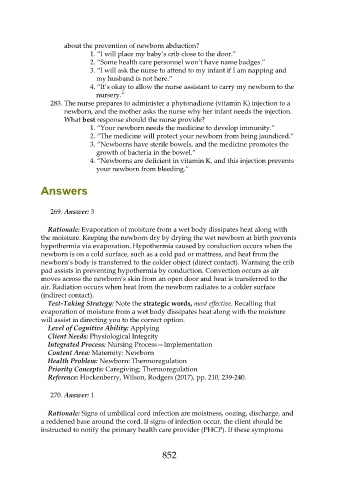Page 852 - Saunders Comprehensive Review For NCLEX-RN
P. 852
about the prevention of newborn abduction?
1. “I will place my baby’s crib close to the door.”
2. “Some health care personnel won’t have name badges.”
3. “I will ask the nurse to attend to my infant if I am napping and
my husband is not here.”
4. “It’s okay to allow the nurse assistant to carry my newborn to the
nursery.”
283. The nurse prepares to administer a phytonadione (vitamin K) injection to a
newborn, and the mother asks the nurse why her infant needs the injection.
What best response should the nurse provide?
1. “Your newborn needs the medicine to develop immunity.”
2. “The medicine will protect your newborn from being jaundiced.”
3. “Newborns have sterile bowels, and the medicine promotes the
growth of bacteria in the bowel.”
4. “Newborns are deficient in vitamin K, and this injection prevents
your newborn from bleeding.”
Answers
269. Answer: 3
Rationale: Evaporation of moisture from a wet body dissipates heat along with
the moisture. Keeping the newborn dry by drying the wet newborn at birth prevents
hypothermia via evaporation. Hypothermia caused by conduction occurs when the
newborn is on a cold surface, such as a cold pad or mattress, and heat from the
newborn’s body is transferred to the colder object (direct contact). Warming the crib
pad assists in preventing hypothermia by conduction. Convection occurs as air
moves across the newborn’s skin from an open door and heat is transferred to the
air. Radiation occurs when heat from the newborn radiates to a colder surface
(indirect contact).
Test-Taking Strategy: Note the strategic words, most effective. Recalling that
evaporation of moisture from a wet body dissipates heat along with the moisture
will assist in directing you to the correct option.
Level of Cognitive Ability: Applying
Client Needs: Physiological Integrity
Integrated Process: Nursing Process—Implementation
Content Area: Maternity: Newborn
Health Problem: Newborn: Thermoregulation
Priority Concepts: Caregiving; Thermoregulation
Reference: Hockenberry, Wilson, Rodgers (2017), pp. 210, 239-240.
270. Answer: 1
Rationale: Signs of umbilical cord infection are moistness, oozing, discharge, and
a reddened base around the cord. If signs of infection occur, the client should be
instructed to notify the primary health care provider (PHCP). If these symptoms
852

